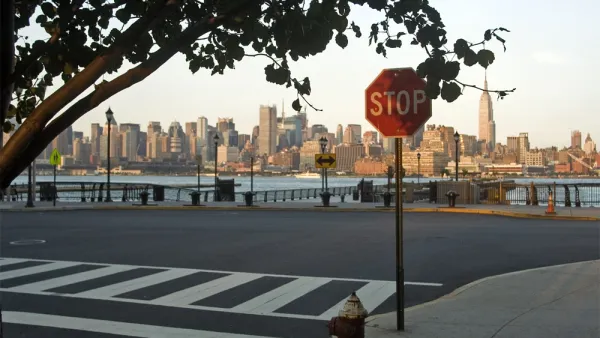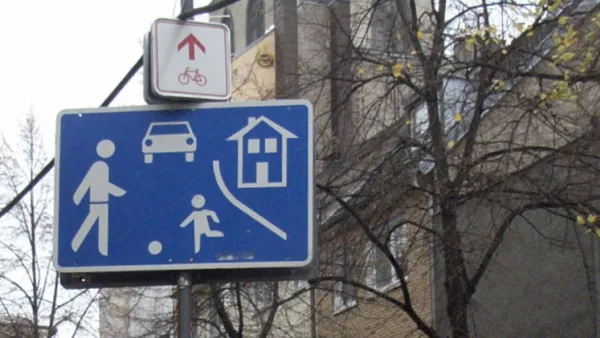Land Use
Paris's Ring Road Turns 40, Is There Any Reason to Celebrate?
Paris's Boulevard Peripherique is one of the most clogged roadways in Europe, it delivers dangerous pollution to 100,000 people in its vicinity, and this year it turned 40. Lara Marlowe looks at the future for one of Paris's little loved landscapes.
A Wave of 'New Cities' Are Poised to Transform Africa - For the Worse?
Jane Lumumba issues a warning about the self-contained cities being comprehensively planned and built from scratch across the continent. Will they benefit international investors and government leaders to the detriment of local residents?
For L.A.'s Union Station, Designers Aim for the Extraordinary
The consultants developing a master plan for L.A.'s historic Union Station have unveiled four design concepts for the station that seek to accomodate high speed rail and improve passenger amenities.
San Francisco Peninsula Struggles with Growth Plan
The Bay Area is finalizing its plan to comply with state legislation to reduce vehicle emissions from transportation. "Plan Bay Area" has aroused fears of regional government and more, which were expressed at a recent public meeting.
Ways to Fail at Form-Based Codes 03: Misapply the Transect
On 50th anniversary of the Jetsons, Hazel Borys celebrates city planning that isn't pie in the sky, but instead lets us cast a shadow.

Reverse Migration Threatens New Jersey Suburbs
After a half century of growth driven by families fleeing New York City, New Jersey's northern suburbs face an uncertain future as young families, young professionals and retirees find a resurgent Big Apple more to their liking.

The Voyage of the Woonerf
Writing in The New York Times, Paul Hockenos describes the revival and global spread of the "woonerf", the Dutch complete street model that's bringing shared public space to cities from Montreal to Auckland.
Urbanism 2.0 vs. 'Micro Urban' Communities: Imagining Land Use in 2063
Patrick J. Kiger looks at the global trends that will impact urban landscapes over the next 50 years and explores two competing visions for the future of land use.
Success of L.A.'s Rail Investments Rely on First and Last Mile Connections
Alex Schmidt looks at efforts to re-'train' L.A. drivers to use the city's growing rail network. Planners are focusing on rezoning areas within a 10-minute walk from stations, but face obstacles in blending density with single-family districts.
The Importance of Retail Design to the Future of Our Cities and Towns
Much of the future built environment will be determined by how commercial sites are developed, says Robert Steuteville. And it's up to cities and towns to demand better retail designs.
Unlocking the Value of Legacy Assets
As cash strapped communities look to maximize their return on investment, a potent argument can be made for leveraging significant investments already made in a city's legacy assets to drive economic development.
Website Provides Tools to Resurrect Abandoned Buildings
The world is full of millions of abandoned buildings; unused resources that drag down their surrounding communities. One website aims to provide advocates with the tools to reactivate them, writes Ben Schiller.
Assessing Criticisms of Form-Based Codes
Since their resurrection in Seaside 30 years ago, roughly 300 form-based codes (FBCs) have been adopted. By their very nature FBCs faces many hurdles.
Dramatic Population Growth Presents Opportunity to Reshape America's Urban Environment
To accomodate America's expected population growth by 2050, the country will need to build up to 74 million new homes. This challenge presents a unique opportunity to reshape our urban environment, says Enrique Penalosa, the former mayor of Bogota.
'Triumph of Suburbia' is a Far-Fetched Story
Joel Kotkin is on a roll in the past few weeks, making the case that the revival of cities and decline of suburbs is a fraud — but his argument ignores the facts, argues Robert Steuteville.
How Facebook Simulates Suburbia: Lessons for Building Public Spaces in the Digital Age
As the virtual and physical worlds become more intertwined, the role of the traditional architect and the information architect become more closely aligned. Emily Badger explores the ways that each discipline can help the other design public spaces.
Can a Fake Plan Lead to Real Results in Raleigh?
Matt Tomasulo's proposal for an urban beach on the site of a vacant lot in Raleigh has gained a following, and sparked a conversation over the future of the site, demonstrating the power of an attractive idea, a compelling rendering and the Internet.
America's Ballooning Disaster Debt
A new report out this week quantifies the federal government's escalating disaster relief spending, a sum that hadn't previously been tabulated and came as a surprise to many.

What Types of Homes Will Be Desirable in 10 Years?
What will America's housing market look like in a decade? Will suburban homes make a comeback? Will the popularity of smaller units in urban environments continue to rise? Robert Shiller looks into his housing market crystal ball and sees haze.
Gas Stations Get Guzzled as D.C.'s Suburbs Densify
Reflecting a nationwide trend, gas stations across the Washington D.C. metro area are disappearing, as rising land values and shrinking margins have station owners eager to sell.
Pagination
Urban Design for Planners 1: Software Tools
This six-course series explores essential urban design concepts using open source software and equips planners with the tools they need to participate fully in the urban design process.
Planning for Universal Design
Learn the tools for implementing Universal Design in planning regulations.
EMC Planning Group, Inc.
Planetizen
Planetizen
Mpact (formerly Rail~Volution)
Great Falls Development Authority, Inc.
HUDs Office of Policy Development and Research
NYU Wagner Graduate School of Public Service


































